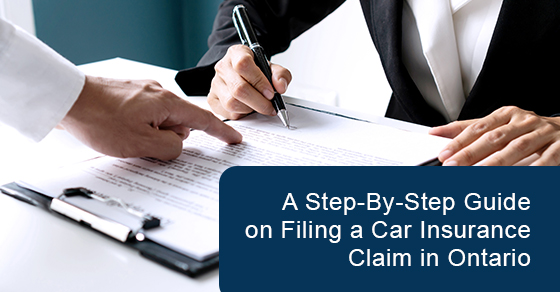
A Step-By-Step Guide on Filing a Car Insurance Claim in Ontario
Filing an insurance claim can be a little intimidating if you don’t know where to begin. In the case of car insurance claims, when an accident is involved, you will need to put together all the information pertaining to the accident. It can be difficult to think about collecting images, police reports and witness statements at the scene, especially if you are injured or shaken up. The good news is, once the information is collected and your claim is filed, our team makes the rest of the process as easy as possible. Here we offer a step-by-step guide on filing a car insurance claim in Ontario to help you receive your payment as soon as possible.
Collect the Facts
You will need the names and registration and insurance company and policy number of the other driver(s) involved in the accident. Also, you’ll want the date and time it occurred, the location, injuries, passengers, extent of vehicle damage, how the accident occurred, etc. The more info you provide, the easier it is to prove who caused the accident. Having this information will help the claim process go through faster.
Review Your Car Insurance Policy
Before reaching out to your insurance company, take a look at your car insurance policy so you understand your coverage. This will also outline any details about your rights and any obligations you might have under the contract. If you don’t have your policy on hand, you might want to request a copy before calling.
Understanding the details of your coverage makes it easier to double-check you have all the information required when you make your claim. It also reduces the stress of finding out certain things aren’t covered. Furthermore, you’ll be better prepared to ask questions about the claims process, and anything regarding your coverage you might not understand.
Report the Accident to Insurance Company
Call your insurance company as soon as possible, preferably within seven days. This can be difficult if you are injured, and we always understand when the report is delayed for medical reasons. However, some policies have a time limit for claims, so delayed reports could mean they are not obligated to honour your claim.
Await Contact from the Claims Adjuster
A claims adjuster will contact you once you report the accident. Their job is to review the information and assess the losses based on your car’s condition. In some cases, they might require you to complete a Proof of Loss form. This form is a sworn statement the information you provided is true. In most cases they will ask questions related to the information you provided, so be sure you have copies of everything you submit.
The Claims Adjuster’s Role
Although people often dread interaction with a claims adjuster, their role is to assess the damage and make sure you receive your payment based on your coverage. They can answer your questions regarding your policy and walk you through what to expect during the claims process.
Always ask for clarification if you don’t understand the process or why something isn’t covered. You have a right to be informed every step of the way. You should remain in contact with your adjuster so you know the status of your claim.
Assessing Fault
Your adjuster has the difficult task of deciding who was at fault. Each driver involved can be at fault to a certain extent. Who is at fault is important because the amount the insurance company pays out and whether your insurance premiums need to be adjusted. Any driver found to be responsible for more than 25% of the accident will have to pay more for their insurance premiums.
Fault is regulated under the Insurance Act and the Fault Determination Rule. This guide provides over 40 possible scenarios adjusters can review to help them decide who is responsible. The same rules apply to all scenarios regardless of the weather or road conditions. A scenario that is closest to the circumstances of your accident is applied unless it is a truly unique scenario. In this case, fault is based on the rules of negligence laws. Whether or not charges are filed following the accident holds no bearing on the fault.
If you are found to be at fault and you disagree, you can contact the adjuster. Ask them how they came to their conclusion so you can offer further proof showing you weren’t at fault, or at least not to the extent they are saying. If this is not resolved to your satisfaction, you can speak to your insurance company’s complaints officer.
Repair vs Total Loss
Once fault is determined, your insurance company determines whether your vehicle can be repaired or is a total loss. Repairs and damages are covered based on the cost, while a total loss pays out the cash value of your vehicle in its condition prior to the accident. Repair costs can’t exceed the actual cash value of your vehicle. If repairs do exceed the value, the insurance company will treat your claim as a total loss.
Your Payment
Your insurance payment is based on the extent of damage, your coverage and your deductible. The most common policies include:
- Mandatory Coverage Only: For these policies, you are entitled to Direct Compensation-Property Damage (DC-PD) which includes damage to the vehicle, a temporary rental vehicle, and damaged personal contents in the vehicle, less the deductible. However, it is also based on the percentage of fault. For example, if the other driver is found to be 100% at fault you get the full amount, whereas if you were found to be 75% at fault, you only receive 25%.
- Collision/Upset Coverage and All Perils Coverage: These policies cover repairs or replacement less the deductible regardless of fault and some belongings in the vehicle depending on the policy.
The adjuster will explain how they came up with your payment and you have the right to dispute the settlement if it seems too low.
Disputes
If you feel the payment offered is unfair, speak to your claims adjuster. Although you will have to provide proof you are entitled to a higher settlement, you do have the opportunity to do so. If you are unable to resolve the issue, you can settle the disagreement through an appraisal under the Insurance Act. An appraiser is assigned to you and your insurance company, and they will try to come up with a fair value for damages. If not, a mediator will make the final decision.
For more information about car insurance in Ontario, call WB White Insurance at 1-877-420-4572 or contact us here.
Leave A Comment
The comments are closed.


